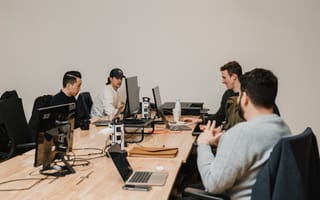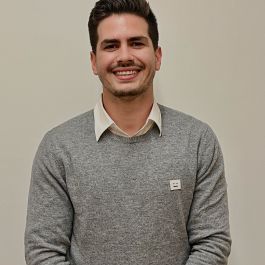Every company professes to abide by a guiding set of principles, and they typically overlap quite a bit. Not a job interview goes by without an applicant learning of a startup’s passion for innovation. Of an organization’s commitment to diversity. Of a people-first approach that keeps employees’ happiness in mind.
Much rarer is a company that actually follows through on the image it projects. We all know what employers are supposed to say in our current lexicon — never mind the challenges of bringing those words to fruition. And yet there was an unmistakable air of authenticity when Presley Mills inquired about a position at Simon Data.
“Our interview process set the tone from the beginning,” said Mills, a senior brand designer at the marketing tech company. “The most important thing is your relationship with your coworkers. You’re going to be on a team, and you have to really fit and feel right with everyone and be supportive of each other. From the beginning, you know that’s part of what the job is.”
A family health scare earlier this year proved the sentiment to be more than just talk. Without hesitation, Mills was given the freedom and support she needed to step away from her job and attend to personal needs.
“I’ve really felt cared for by the people at Simon,” Mills said. “Everyone has always stepped up and done that. It totally lifts the mental burden that happens when you aren’t sure if you can take the time off when you need it.”
Simon’s people-first approach has only evolved during the pandemic. The New York-based tech company recently introduced a new hybrid work model, unveiling a renovated office in the heart of SoHo while simultaneously empowering its employees to work remotely as often as they please.
Simon’s work hybrid percentages:
The pandemic’s rapid and destabilizing advance across the globe has ushered in a cultural reset within the workforce, people operations coordinator Zach Shapero said. Whether due to a shift in perspective or a desire to retain and attract top talent, companies are implementing a forward-thinking approach to nurturing the health and well-being of their employees.
“We’ve learned that you can be successful in the office, but you can be equally as successful when you work from home,” Shapero said. “Having that flexibility and allowing people to choose is one of the reasons why Simon has adapted so favorably.”
To find out more about Simon’s back-to-work plan, Built In NYC sat down with Shapero, Mills and account executive Ben Lopategui to discuss how the company’s hybrid work model was designed with employees in mind, and how it allows team members to thrive both at work and at home.

What does the new office look like?
Shapero: It’s in a five-story building, and we have the entire second floor to ourselves. It’s a very open environment. We have about six telephone booths stationed throughout the office so people can jump in and take a quick Zoom meeting or phone call. We also have multiple conference rooms that can fit as few as two people to about 16 people, so that’s also super efficient if people want to meet with clients or an internal team wants some privacy. We also have a designated kitchen and a lounge area where we can play a quick game of chess or Connect Four. We even recently added a basketball hoop — designated times for that, because you don’t want to be too loud. It’s a great balance between a space that focuses on concentration and collaboration, while also having a peaceful and zen environment.
It’s a great balance between a space that focuses on concentration and collaboration.”
What are the benefits of Simon’s new hybrid work model?
Shapero: Having the flexibility to work from home, it kind of eradicates the stress and frustration that comes with commuting. I love going into the office as well, but that commute can take a toll on you. On days you don’t go into the office, you wake up feeling a lot more calm and relaxed.
Lopategui: I’m fortunate that I’ve been told my meetings with clients can take priority over internal meetings, so I can ask someone, “Hey, would you mind moving this so we can have this meeting with some prospects? They’re getting really close to signing, and we kind of have to move fast here.” The transparency and willingness to work together is great.
How does Simon demonstrate a people-first mentality in the workplace?
Shapero: People-first and taking everyone’s mental health into account is something we take very seriously here at Simon. We obviously value employees’ physical health as well, but especially their mental health. It’s something that’s very important and something that’s come up a lot in the past couple of years.
Mills: I was freelance before joining Simon, which can be kind of a demanding job, and what Simon has given me is the ability to finish my task and set my own schedule in a way that I’m still meeting the requirements, but I don’t feel guilty about taking days off randomly if I’m not feeling well or I just need a mental break. We’ve been fostering dogs, so I always just have dogs coming in and out of the house. My lunch breaks are often spent taking animals outside.
The transparency here really contributes to the overall sense of comfort.”
Lopategui: The transparency here really contributes to the overall sense of comfort. If you’re not comfortable or you’re busy and need to step away for a moment, it’s fine. No one blinks twice. There’s a really good culture here of supporting that. There’s a certain talent pool that really values that flexibility of being treated like an adult so that, as long as you’re getting your work done and you’re hitting the right results, you should be free to manage your time as you please. We’re results-driven, and while I think that sometimes has a negative connotation, we understand that what gets results is different for each human. Some of those small things are super helpful when you’re trying to figure out the best way to work remotely.
Simon’s Core Values
- Build Strategically
- Learn & Develop
- Respect Everyone
- Listen & Share
- Take Ownership
What informal or formal initiatives across the company have helped connect remote employees?
Shapero: We use the apps Eden Health and Eden Workplace, which are essentially telehealth apps that connect people with care and in-person clinics in real time. On days that our employees are coming into the office, they take a daily Covid-19 screener, which includes five questions about things like whether they’re experiencing any symptoms or if they’ve recently been in close contact with someone who tested positive. Once they’re done answering those five questions, they’ll get a confirmation on whether or not they’ve been cleared to come into the office, or if they should stay home for that day. But that’s just one of the services that the Eden apps offer. They can also book Covid PCR tests, rapid tests and even book a flu vaccine appointment if users want one. We hope that none of our employees test positive for Covid, but if they do, we can go back and track where they sat in the office that day and see who sat in the vicinity to inform them that it might be smart to get a test, just as a precautionary measure.
Lopategui: One thing that’s worth noting is that our engineering team has always been remote, and we’ve been able to learn a lot from that team. They had a remote employee resource group for quite some time before Covid happened, which has been helpful as a salesperson. When I started, we were 100 percent based in New York, and now we’re at 40 percent New York, 60 percent remote.

How does Simon’s approach to working remotely position the company favorably with employees?
Mills: It was just giving us the choice. We’re independent human beings who can make the decision about how we work best, and everyone can decide that for themselves. Simon never put any kind of pressure or expectations that they need to babysit us. They trust that we’ll do our work to the best of our abilities wherever we choose to be.
They trust that we’ll do our work to the best of our abilities wherever we choose to be.”
Lopategui: As we interview folks and try to grow our team, it’s definitely a differentiator for applicants who might have recently moved or started a family or want to live somewhere with a lower cost of living than New York or San Francisco, which have historically been viewed as the two big tech hubs. They love the flexibility, and it’s becoming a nonstarter for most folks in the initial conversation if you’re not willing to offer that. A question I get asked all the time when I’m interviewing folks is, “What’s the culture like in the office?” but also, “How will you support people like myself who will not have the chance to interact in person?” There’s been a lot of effort to make sure that people who are stuck working from home are able to bring their best selves to work.






